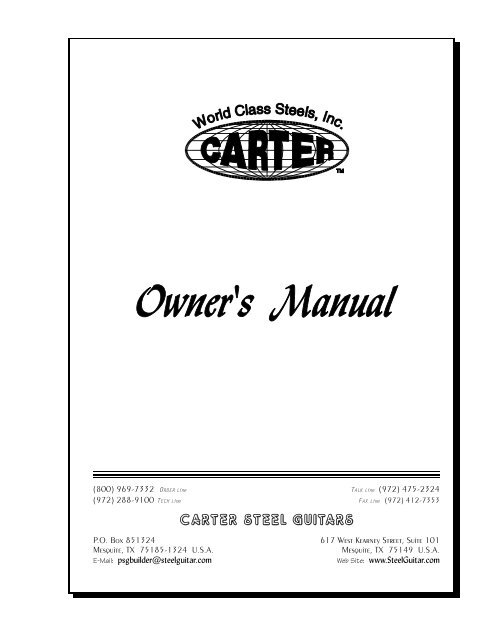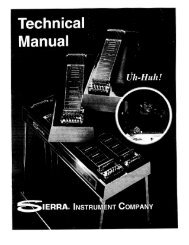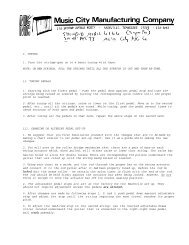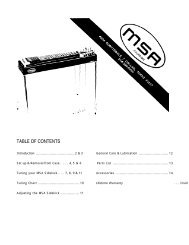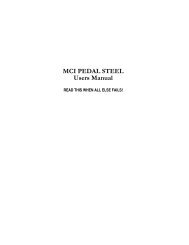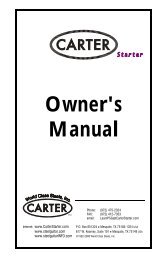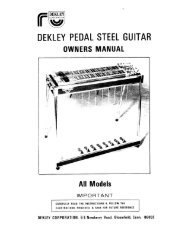You also want an ePaper? Increase the reach of your titles
YUMPU automatically turns print PDFs into web optimized ePapers that Google loves.
CONGRATULATIONS!world today!You are now the lucky owner of the best pedal steel guitar available anywhere in thelifetime.With normal care and maintenance, your <strong>Carter</strong> <strong>Steel</strong> Guitar should last aPlease take a few minutes to read through and familiarize yourself with this <strong>Owner's</strong><strong>Manual</strong> so you can become familiar with the general mechanics and care requirements ofyour new <strong>Carter</strong> <strong>Steel</strong> Guitar.For your convenience, we keep computer and video records of each guitar andsetup so we can assist you in answering any questions or helping you make any changesto your setup.Once you have read through this <strong>Owner's</strong> <strong>Manual</strong>, please feel free to call us withany questions you might still have.
To remove the guitar from the case: lean over the guitar, and grasp one (1) ofthe front legs in one hand and one (1) of the rear legs in the other hand [hold these two (2)legs close to the body of the guitar]. Carefully lift the guitar straight up. Now, slowly allowthe guitar to turn over to its vertical position, setting the front legs on the floor first and thenallowing the back legs to settle onto the floor.NECK SELECTORDouble-neck guitars are equipped with a 2-position neck selector switch, which letsyou select:1. The front neck only: extreme left position; and2. The back neck: extreme right position.Figure 108/97 Rev. G - 2 -ASSEMBLY / NECK SELECTOR
TUNING YOUR <strong>Carter</strong> <strong>Steel</strong> GuitarTuning Pedals, Knee Levers & Open StringsThe following procedure is used for tuning your <strong>Carter</strong> <strong>Steel</strong> Guitar. (<strong>Carter</strong><strong>Steel</strong> <strong>Guitars</strong> equipped with half-stops and/or tuneable splitters are described later.)1. Tuning the strings: Without depressing any pedals, tune each string to thedesired pitch by using the tuning keys. Work the pedals up and downoccasionally while tuning to insure that the strings are properly stretched.2. Tuning the pedals & knee levers: Depress the pedal to be tuned and notethe movement of the tuning nuts on the right end-plate. The holes in theend-plate correspond to the string positions. There are six (6) holes for eachstring. The three (3) bottom rows lower string pitch and the three (3) top rowsraise string pitch. To lower the string pitch further, use the tuning wrench on thethree (3) bottom rows and turn the tuning nuts in a clockwise direction.Repetition of this procedure on the three (3) top rows of tuning nuts (and turningin a clockwise direction) raises the string pitch. With the pedal fully depressed,turn the proper tuning nut by using the tuning wrench provided, until the desiredpitch is reached. Turning the nut clockwise will increase the movement of thestring. Turning the nut counterclockwise will decrease the movement of thestring. Repeat this procedure for the knee levers.Note: A slight amount of slack is necessary in the linkage system to provideroom for normal tuning. This slack has been pre-adjusted at the factory for yourgauges and tuning(s). (See "Your Personal Tuning Chart", Page 13.)There should be slack in the pulling train. If the adjusting nut is turned too farin the clockwise direction, the string will not return to proper pitch after the pedalis released. If this happens, the tuning nuts should be turned in acounterclockwise direction until they no longer affect the pitch of the string withthe pedal not depressed and the total pedal travel should be readjusted. (Seealso Pedal Stop Adjustment on Page 5, Number 2.)08/97 Rev. G - 3 - TUNING
Tuning the "Half-Stop"The "half-stop" on the 2nd string (E = ) string of the E 9 tuning is adjusted as follows:1. Tune the open tuning with the key as usual.2. Tune the full-tone change (E = to C < ) with the respective nylon hex nut.3. Tune the half-tone lower "feel" by adjusting the nylon hex nut for the half-stop.This nut should be adjusted to contact the half-stop changer finger when the 2ndstring reaches its half-tone change (E = to D). (See Figure 2, Below.)Figure 2Tuning the Tuneable-SplitsThis optional feature allows you to have a combination tuning on strings which areraised one (1) full tone and lowered one-half (½) tone (or vice versa).The tuning procedure for guitars equipped with tuneable-splits is as follows:1. Tune open tuning keys with the keys as usual.2. Tune raises with the nylon nuts as usual.3. When both the raise and lower function are engaged at the same time,the resultant note is tuned with the nylon nut that lowers the string.Turn clockwise to lower the note.4. Finally, tune the lowered note alone with the respective Black raise nylon nut.08/97 Rev. G - 4 - TUNING
ADJUSTING YOUR <strong>Carter</strong> <strong>Steel</strong> Guitar1. Pedal Height: The height of the pedals from the floor can be adjusted byloosening the lock nut on the pull rod at the ball-joint connection. Once the locknut has been loosened, the ball-joint can be screwed in or out as desired.The lock nut should then be re-tightened. (See Figure 1, Page 2.)2. Pedal Stop Adjustment: To get more travel out of a pedal, the pedal stopmust be readjusted under the guitar by using a 1/16" Allen Wrench for the pedalstop set screw. Turning the screw clockwise will decrease the travel of thepedal. Turning the screw counterclockwise will increase the pedal travel.(See Figure 3, below.)Figure 308/97 Rev. G - 5 - ADJUSTMENTS
3. Knee Lever Travel: Knee Levers can have their amount of travel increasedor decreased in either or both of the following ways (See Figure 4, below.):(a) Adjust the stop adjustment screw; and/or(b) Loosen one (1) of the hex screws in the linkage, changing the position ofthe pin or barrel nut, and realigning the lever by allowing the linkage rodto slide in or out of the pull pin until the desired amount of travel isobtained. The hex screw should then be re-tightened.Please Note: Method (b) will change the ease, as well as the amount,of travel.4. Knee Lever Tilt: Each knee lever has an individual tilt adjustment screw.This screw does not affect the tuning or function of the knee lever; it only affectsthe position of the knee lever. Adjust the screw to bring the knee lever to theposition you desire and re-tighten the locking nut. (See Figure 4, below.)5. Knee Lever Slack: Knee lever "back-slack" is fixed and preset at the Factory.The slack stop screw is NOT adjustable. (See Figure 4, below.)Figure 408/97 Rev. G - 6 - ADJUSTMENTS
6. Leverage Options: Your <strong>Carter</strong> <strong>Steel</strong> Guitar has more leverageoptions than most other pedal steel guitars available. All rods have been placedin pull and finger holes that give the most balanced and even pulls for yoursetup. The pull-finger has five (5) holes, which are used for balancing two (2)or more pulls, and for desired speed of pull. Each of the five (5) holes hastwo (2) adjustments: pull-rod over the pull-pin and pull-rod under the pull-pin.This design makes possible ten (10) different pull adjustments. If you want torelocate a pull-rod: merely unscrew the nylon tuning-nut, reposition the rod inthe desired position, and re-tune.(See Figure 5, below and Figure 6, Page 8.)Figure 508/97 Rev. G - 7 - ADJUSTMENTS
Figure 6REVISING OR ADDING TO YOUR PEDAL SETUPThe <strong>Carter</strong> <strong>Steel</strong> Guitar all-pull system is designed to allow changes or additionswith a minimum of effort. This is done by using a "pull finger" [the part with the five (5)holes] which can be inserted on the square crank shaft without removing anything else onthat shaft. Once in place in the desired position on the shaft, insert the button-head screwand tighten snugly, plus ¼-turn. NOTE: Do NOT attempt to over-tighten this screw.Insert the threaded end of the pull rod into the proper changer finger hole. The pull-pin maythen be inserted into the proper finger hole, the rod hooked onto the pull-pin, and the tuningnut attached. (See Figure 6, Above.) {If you order additional knee levers and pedals in thefuture, instructions for adding them will be sent to you at that time.}08/97 Rev. G - 8 - REVISIONS TO PEDAL SETUP
GENERAL CARE & MAINTENANCEYour new <strong>Carter</strong> <strong>Steel</strong> Guitar is a precision instrument. Like any precisioninstrument, proper care and lubrication will greatly enhance the guitar's appearance,performance, and value. Generally, on laminate or lacquered finishes, never use any typeof abrasive cleaner. Laminate and wood can be cleaned and polished by using a good"show car" finish, like Meguiar's Mirror Glaze Professional ® #7 1 and buffing with a soft,clean cloth. Aluminum and chrome can be be cleaned and polished with a good,non-abrasive cleaner, such as Alumag-Chrome Metal Polish ® . 2Note: When using SPRAY-type polishes or cleaners, NEVER spray themdirectly at or onto any part of the guitar. Instead, spray the productonto a soft cloth and apply to the appropriate part of the guitar withthe cloth.Since your new <strong>Carter</strong> <strong>Steel</strong> Guitar has been pre-lubricated and fully adjustedat the factory, it requires very little, if any, further adjustment except for personal "feel".Lubrication must be done on all pivot points under the guitar, about two or three timesper year. A light, high-grade machine oil is recommended and 30W motor oil is okay.Lubrication1. Undercarriage: All moving parts in the pull system are on Delrin ® , nylon orbronze bushings and have been lubricated as needed. Lubricate several timeseach year with a light oil.2. Changer: The changer has been pre-lubricated during assembly. Lubricatewith lightweight machine oil (3-in-1 or equivalent) several times per year.3. Roller Nut: This area requires occasional lubrication to insure proper stringreturn. A liquid Teflon ® -based lube is recommended (a light machine oil alsois okay). WARNING: DO NOT use WD-40 (or the equivalent) on the rollers orany part of the guitar because this evaporates and leaves a gummy residue,which eventually causes the moving parts to stop moving freely.4. Pedals: The pedals are mounted on a Delrin ® shaft. To keep the pedalsworking freely, use a small drop of light oil at each pedal-end a couple timeseach year. Please Note: The ball joint connection at the pedal rod-end is notlubricated. If a slight squeak should occur in one of these, use a small drop oflight oil.1 Available at most auto parts stores. Or: Meguiar's, Inc., Irvine, CA 92714, USA.2 Available through Karseal Corp., 11552 N. Hart St., N. Hollywood, CA 91605, USA; (800) 276-5474, (818) 765-7681 FAX.08/97 Rev. G - 9 - CARE & MAINTENANCE
Adjusting the Changer Return SpringsNOTE: Do NOT attempt this until you have exhausted all other possibleremedies to this problem (such as lubrication, string ball ends stuck inmechanism, etc.)The return springs for the lowering finger of the changer have been adjusted at thefactory, and normally require no further adjustment. No helper springs are needed on<strong>Carter</strong> <strong>Steel</strong> <strong>Guitars</strong>.The return spring must always be tight enough to hold the lowering finger againstthe stop bar while the raise finger makes its complete travel. If the lowering finger pullsaway from the stop bar slightly: unhook the spring from the finger, cut one coil from thereturn spring, and then re-hook the spring on the lowering finger.StringsUnless you've specified otherwise, <strong>Carter</strong> <strong>Steel</strong> <strong>Guitars</strong> come from thefactory in the gauges listed in the two (2) charts below.When replacing strings, we recommend using strings in the gauges listed in thetwo (2) charts below (See Pages 11 and 12). A deviation from these may require a slightadjustment of the nylon tuning nuts; or it might require relocation of a pull rod in the 5-holepull finger. (See also Leverage Options on Page 7, Number 6.)08/97 Rev. G - 10 - CARE & MAINTENANCE
STRING GAUGES USED ON <strong>Carter</strong> <strong>Steel</strong> <strong>Guitars</strong>'Standard 10-String TuningsStringNumberE 9 C 6BasicTuningStringGaugeStringNumberBasicTuningStringGauge1 F < .012 1 G .012(or D) (or .015)2 E = .015 2 E .0143 G < .011R 3 C .0174 E .014 4 A .0205 B .017 5 G .024W6 G < .022 6 E .030W7 F < .026W 7 C .036W8 E .030W 8 A .042W9 D .034W 9 F .054W10 B .036W 10 C .068WR = ReinforcedW = Wound08/97 Rev. G - 11 - STANDARD STRING GAUGES (D-10 & S-10)
STRING GAUGES USED ON <strong>Carter</strong> <strong>Steel</strong> <strong>Guitars</strong>'Standard 12-String TuningE 9 / B 6String Number Basic Tuning String Gauge1 F < .0122 E = .0153 G < .011R4 E .0145 B .0176 G < .0207 F < .024W8 E .030W9 B .036W10 G < .042W11 E .054W12 B .068WR = ReinforcedW = Wound08/97 Rev. G - 12 -STANDARD STRING GAUGES (S-12)
6/93 Rev. B - 13 - YOUR PERSONAL TUNING CHART
Re: Model No.: ________________________Limited One-Year WarrantySerial No.: ________________________This new <strong>Carter</strong> <strong>Steel</strong> Guitar is warranted to the Original Purchaser,____________________________________________, to be free from defects in bothmaterial and workmanship for a period of ONE (1) YEAR from Date of Original Purchase.Date of Original Purchase is determined by adding seven (7) days to date of shipment fromfactory or, if received at the factory, date of receipt. The Original Purchaser must be anindividual person. Names of bands, clubs, churches, groups, institutions, organizations, etc.are not acceptable as the Original Purchaser.Should any part of your new <strong>Carter</strong> <strong>Steel</strong> Guitar be defective, it will berepaired or replaced free-of-charge (except transportation), provided it has been operatedaccording to the instructions in this <strong>Owner's</strong> <strong>Manual</strong>, which accompanied the guitar whendelivered to Original Purchaser. Should any trouble develop during this one-year period,return the COMPLETE guitar, freight prepaid, to World Class <strong>Steel</strong>s, Inc. dba <strong>Carter</strong> <strong>Steel</strong>Gu i tars' (hereinafter "WCSI") factory or to an Authorized Service Center. You mayobtain in the location of the Authorized Service Center nearest you by contacting thefactory.This Warranty does not apply to: guitar cases, strings, tunings, adjustments, orsurface finishes. Additionally, this Warranty does not apply where repairs are requiredbecause of normal wear and tear. This Warranty is void if, in the sole judgment of WCSI:1. Guitar has been damaged by abuse, accident, misuse, mishandling,the elements, or improper maintenance;2. Repairs or alterations have been made or attempted by anyone otherthan the WCSI factory or Authorized Service Center; or3. Adaptation or accessories, other than those provided orrecommended by WCSI, have been made or attached.In no event shall WCSI be liable for any indirect, incidental or consequentialdamages from the sale or use of the product. This disclaimer applies both during and afterthe term of this Warranty.WCSI disclaims liability for any implied warranties, including, but not limited to,implied warranties of "merchantability" and "fitness for a specific purpose," after theone-year term of this Warranty.This Warranty gives you specific legal rights, and you may also have other rightswhich vary by geographic location. Some areas do not allow the exclusion or limitation ofincidental or consequential damages, so the above limitation or exclusion may not apply toyou. Some areas do not allow limitation on how long an implied warranty lasts, so theabove limitation may not apply to you.08/97 Rev. G - 14 -LIMITED ONE-YEAR WARRANTY


